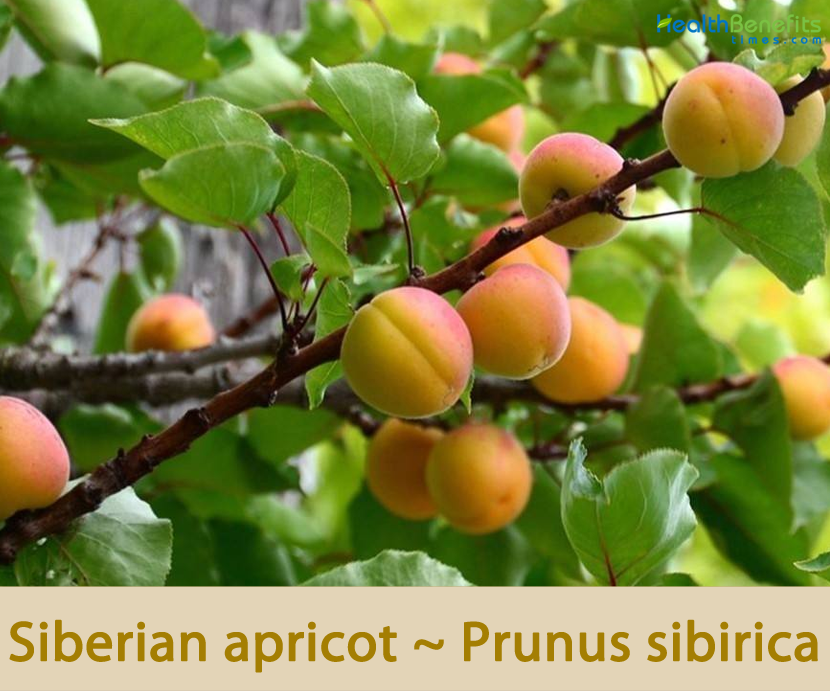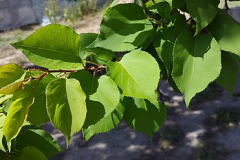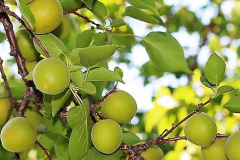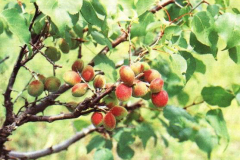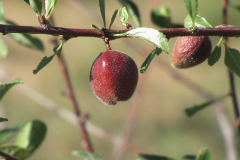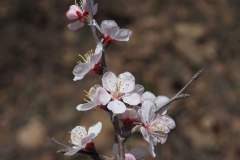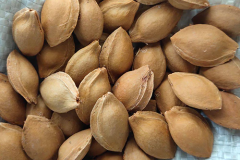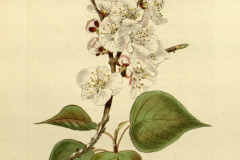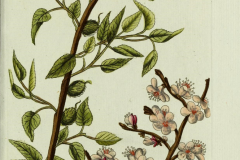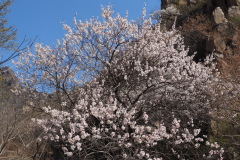| Siberian apricot Quick Facts | |
|---|---|
| Name: | Siberian apricot |
| Scientific Name: | Prunus sibirica |
| Origin | Eastern China, Japan, Korea, Mongolia and eastern Siberia |
| Colors | Yellow to orange-red, but on the side facing the sun they are reddish |
| Shapes | Fruit is covered with a velvety skin and is about 1 in. long. The dry and densely textured flesh (mesocarp) easily separates from the stone |
| Health benefits | Support coughs, asthma, acute or chronic bronchitis, constipation, stimulates respiration, improves digestion and gives a sense of well-being |
| Name | Siberian apricot |
|---|---|
| Scientific Name | Prunus sibirica |
| Native | Eastern China, Japan, Korea, Mongolia and eastern Siberia |
| Common Names | Siberian apricot, Mongolian apricot |
| Name in Other Languages | Armenian: Sibiryan tsiran (Սիբիրյան ծիրան) Bulgarian: Sibirska kaĭsiya (сибирска кайсия) Chechen: Sibrekhan tuŭrk (Сибрехан туьрк) Chinese: Shan xing (山杏), Xi bo li ya xing, Meng gu xing, Ku xing ren Czech: Meruňka sibiřská English: Siberian apricot, Mongolian apricot Estonian: Siberi aprikoosipuu French: Abricotier de Sibérie, Abricot de Mongolie German: Sibirische Aprikose, sibirischer Aprikosenbaum Italian: Albicocco siberiano Japanese: Mouko anzu, Mouko anzu Kazakh: Sibir örigi (Сібір өрігі) Korean: Si be ri a sal gu (시베리아살구) Persian: پرونوس سیبری Russian: Abrikos sibirskii (Абрикос сибирский) |
| Plant Growth Habit | Deciduous shrub or a small tree |
| Growing Climates | Dry sunny slopes amongst shrubs, forests, thickets, hill grasslands and river valleys |
| Soil | Thrives in a well-drained moisture-retentive loamy soil, growing well on limestone. It also prefers some lime in the soil but is likely to become chlorotic if too much lime is present. The plant succeeds in sun or partial shade though it fruits better in a sunny position |
| Plant Size | 2 – 5 meters tall |
| Bark | Dark grey, while the bark of the branches is reddish to dark brown, sparsely hairy at first, but soon glabrous |
| Buds | Ovoid to conical, 2–4 mm long and the edges of the bud scales are hairy |
| Leaf | Simple, ovate to almost circular, pointed leaf blade has a length of 5 to 10 centimeters and a width of 3 to 7 centimeters with a rounded to heart-shaped base |
| Flowering season | March |
| Flower | Flowers mostly solitary, white or pink. The flower stalk is about 1 to 2 mm long, and the bell-shaped flower cup is purple outside and hairy at the base, glabrous, or slightly downy. The flowers are hermaphrodite, with a diameter of 1.5 to 3.5 cm |
| Fruit Shape & Size | Fruit is covered with a velvety skin and is about 1 in. long. The dry and densely textured flesh (mesocarp) easily separates from the stone (endocarp) and opens along the ventral suture at full maturity |
| Fruit Color | Yellow to orange-red, but on the side facing the sun they are reddish |
| Propagation | By Seed |
| Season | July to August |
| Varieties |
|
Plant Description
Siberian apricot is a deciduous shrub or a small tree that normally grows about 2 – 5 meters tall. The plant is found growing in dry sunny slopes amongst shrubs, forests, thickets, hill grasslands and river valleys. The plant thrives in a well-drained moisture-retentive loamy soil, growing well on limestone. It also prefers some lime in the soil but is likely to become chlorotic if too much lime is present. The plant succeeds in sun or partial shade though it fruits better in a sunny position. The bark is dark grey, while the bark of the branches is reddish to dark brown, sparsely hairy at first, but soon glabrous. The reddish-brown winter buds are ovoid to conical, 2–4 mm long and the edges of the bud scales are hairy.
Leaves
The simple leaves have stipules. The petiole of the leaves is initially hairy, but soon bald, and is red with a length of 2 to 3.5 cm and few if any glands. The simple, ovate to almost circular, pointed leaf blade has a length of 5 to 10 centimeters and a width of 3 to 7 centimeters with a rounded to heart-shaped base. Leaf surfaces are initially reddish, hairy and downy, later glossy green and glabrous. The leaf edge is serrate (not double serrate).
Flowers
Blossoms appear in early spring as solitary flowers. The flower stalk is about 1 to 2 mm long, and the bell-shaped flower cup is purple outside and hairy at the base, glabrous, or slightly downy. The flowers are hermaphrodite, with a diameter of 1.5 to 3.5 cm. The five free petals, almost circular to ovoid in shape, are white with pink veins. The many free stamens are nearly as long as the petals.
Fruit
The fruits, maturing in early- to mid-summer, are yellow to orange-red, but on the side facing the sun they are reddish. The fruit is covered with a velvety skin and is about 1 in. long. The dry and densely textured flesh (mesocarp) easily separates from the stone (endocarp) and opens along the ventral suture at full maturity. The flesh is scanty, dry, harsh and scarcely edible. It may be only 2.5 to 3 mm thick. The compressed spherical stone inside the fruit has a smooth surface, and a diameter of 1.2 to 2.5 centimeters. The seed inside is hardly edible and somewhat bitter.
Different Varieties of Siberian Apricot
Four varieties have been recognized (under the species name Armeniaca sibirica)
- Var. sibirica: The leaf blade and petiole are mostly bare. The flowers are single with a diameter of 1.5 to 2 cm.
- Var. multipetala: The leaf blade and petiole are bald. The large flowers are 3 to 3.5 cm in diameter. It only grows on slopes at altitudes of about 400 meters in eastern Hebei province, China.
- Var. pleniflora: The leaf blade and petiole are initially hairy. The flowers are 3 to 3.5 cm in diameter. It only grows in mountainous regions at altitudes of about 800 meters in western Liaoning province China.
- Var. pubescens: The leaf blade and petiole are initially hairy, but later, only the ramifications of the veins on the underside of leaves are hairy. The flowers are single with a diameter of 1.5 to 2 cm.
Traditional uses and benefits of Siberian Apricot
- The seed is analgesic, anti-asthmatic, antiseptic, antitussive and emollient.
- It is used in the treatment of coughs, asthma, acute or chronic bronchitis and constipation.
- In small amounts this exceedingly poisonous compound stimulates respiration, improves digestion and gives a sense of well-being.
- Different parts of the tree are used in China in the folk medicine.
Culinary Uses
- An edible oil resembling olive oil is obtained from the seed, and used as a substitute for almond flavoring.
- The fruit is eaten raw or cooked.
- The fruit is occasionally eaten but is sour and scarcely edible.
- The fruit seed is eaten raw or cooked and has a bitter taste.
Other Facts
- It is a potential rootstock for apricots.
- A green dye can be obtained from the leaves.
- A dark grey to green dye can be obtained from the fruit.
- Oil obtained from the seed is suitable for use in light industry.
- The wood is of high quality, but is generally too small for most purposes.
Precautions
- In small quantities, hydrogen cyanide has been shown to stimulate respiration and improve digestion, it is also claimed to be of benefit in the treatment of cancer.
- In excess, however, it can cause respiratory failure and even death.
- In larger concentrations, however, cyanide can cause gasping, weakness, excitement, pupil dilation, spasms, convulsions, coma and respiratory failure leading to death.
References:
https://pfaf.org/user/Plant.aspx?LatinName=Prunus+sibirica
https://gd.eppo.int/taxon/PRNSB
https://en.wikipedia.org/wiki/Prunus_sibirica
http://temperate.theferns.info/plant/Prunus+sibirica


